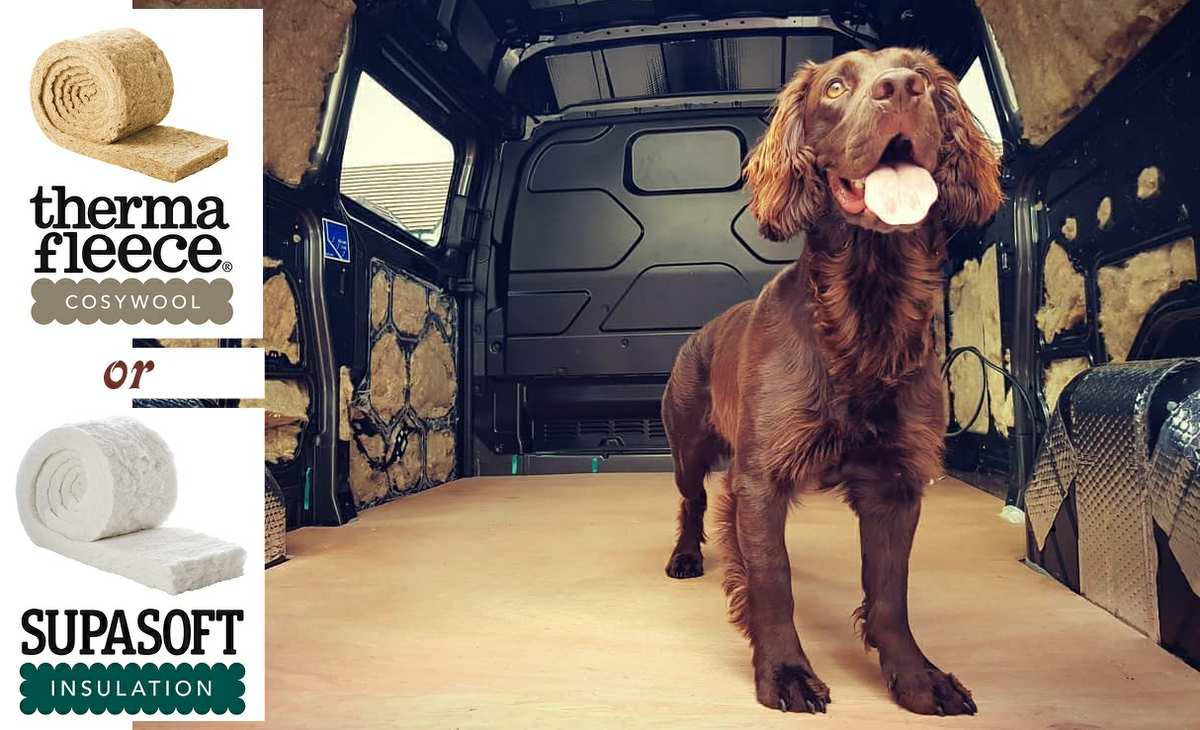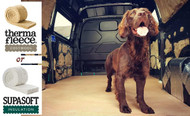Insulating a camper van using Thermafleece insulation FAQs
Posted by Ian, Celtic Sustainables on 20th Jul 2022
We sell a lot of rolls of wool insulation and recycled plastic insulation to people who are converting their van. We have put together answers to the frequently asked questions about insulating vans.

Photo credit. Kirsty and Barra @earlyadvantures
What are the benefits of using Thermafleece insulation products for insulating a camper Van?
- Good thermal Value – Both the Thermafleece Cosywool, (Sheepswool) and the Thermafleece Supasoft (Recycled Polyester) have better thermal values than fibreglass and Rockwool.
- Non toxic – safe to use in confined spaces
- Non irritant – itch free and safe to handle, so no need for gloves.
- Good acoustic insulation – offers a good level of acoustic insulation as well as the improved thermal properties
- Easy to install in odd shaped spaces – the flexible nature of the Thermafleece insulations allows them to be squeezed into corners and odd shaped areas reducing thermal bridges where heat can escape.
Extra Benefit of the Cosywool Sheepswool Insulation
- Natural fibres such as sheepswool are hygroscopic. This means that during times of high humidity they will absorb and lock away the extra moisture present in the air and prevent it condensing on the metal bodywork. When the humidity levels drop again the sheepswool will release the moisture back into the air as vapour. Interestingly, Sheepswool can lock away up to 40% of it’s weight in water without compromising the thermal values.
Membranes and Vapour Barriers
Do I need a Vapour Control Barrier?
This is a topic widely debated on Vanlife blogs and social media pages.
Cooking, boiling kettles and even breathing generates a lot of moisture which will condense on cold metal.
As mentioned above, the Cosywool will stop a certain amount of moisture getting to the bodywork of the van, however it will only absorb a finite amount and if there is an excess of moisture it may become saturated reducing the thermal value and allowing moisture to pass through. Adding an extra protective layer in the form of a membrane, will reduce the amount of water passing into the cavity and ultimately to the cold metal.
The recommendation from Thermafleece is that you use a smart membrane such as the Thermofloc VSD membrane over the insulation. Smart membranes have two states, open (when humidity is low) and closed (when moisture levels are high) When humidity levels are high the pores in the membrane will close and stop any water vapour passing through. During times of low humidity, the pores in the membrane will open and allow any excess moisture that is trapped in the cavity to escape.
Similarly when using the Supasoft, a vapour barrier will prevent excessive amounts of moisture entering into the cavity where it could condense on the cold metal of the bodywork. A solid vapour barrier (e.g. a plastic sheet) will in theory keep moisture from inside the van from passing though to the cavity, however creating a total seal can be difficult and any moisture that did manage to get into the cavity from the van interior or through possible leaks in the bodywork, would get trapped in the cavity and cause corrosion.
Measuring up
What thickness of insulation should I use?
The thickness you choose, really depends on what you can fit in the space between the bodywork and the cladding. You don’t need to leave an airgap so if you measure the distance between the outer skin of the bodywork and where you are going to fix the cover boards, this is the thickness of insulation you will need.
Can I compress the insulation?
If you find that the above measurement falls between two available thicknesses then you should go for the thicker option to ensure maximum thermal benefit. Opting for the oversized option, will give a tight fit and minimise areas where heat can escape.
A lot of people express a concern that the insulation shouldn’t be compressed, it is true that the thermal properties will be reduced slightly, however it won’t make a huge difference and it won’t suddenly stop insulating if you squash it a bit.
Once you have established the thickness of insulation required, you will need to calculate how many rolls to buy.
How do I calculate the quantity of insulation I need?
To accurately calculate the amount of insulation required for your conversion, you will need to measure your vehicle.
The easiest way is to measure each panel that needs to be insulated. So, for instance the roof, the floor, the side panels and the back doors. Measure the height and the width of a panel and multiply the 2 numbers together to get the area. E.g. width (2m) x height (1.5m) = 3m2. Do this for each area that needs insulating and then add them all together to get the total area to be insulated.
On our website, go to the product page of your chosen insulation where you will see the different available sizes listed. Choose the thickness and width you require and you will see a number in brackets, this number is the coverage of 1 roll.
Now for a bit more maths. Divide the total area by the coverage of the insulation the result is the number of rolls needed. e.g if the total area to be insulated is 20m2 and you have decided to use the thermafleece which is 50 x 570 x 13000 (7.41m²), divide 20 (the area) by 7.41 (the coverage) = 2.69. So in this example you would need to order 3 rolls.
Installation
How do I hold the insulation in place?
Strips of double-sided carpet tape applied to the metal of the van body will hold the insulation in place while you fix the cladding over the top. You could also use a spray glue. Once the covering board has been fitted it should further hold the insulation in place through friction.
Is it easy to cut?
The Cosywool and Supasoft insulations can both be cut with a sharp craft knife or a scalloped blade like a bread knife. Alternatively, you can simply tear it apart into manageable size pieces.
Which option to go for?
We supply insulation to several commercial camper van conversion companies, who choose both the Cosywool and the Supasoft for their great thermal and acoustic properties. So, you can be reassured that whichever option you go for you will be making the professional choice.
What have other DIY'ers done?
Read about vanlife enthusiasts Craig, Kirsty and Barra (dog) and van converters Matt, Sarah, Bill (dog) in our article Eco Campervan Conversion – Insulating your Campervan. Or find out about Rosie Sherwood's van insulation thought process in our blog post Eco Campervan Conversion Using Thermafleece Cosywool with Rosie Sherwood.


